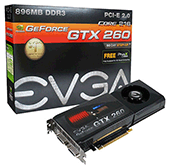Welcome to another Solid Review! This EVGA GTX 260 Core 216 article is one of a three part series for entry-level, mid-level, and high-end gaming with EVGA GeForce cards. In the first part of our series, we covered the original 65nm GTS 250, a standard edition card which is the most ‘entry-level’ of the series. The high-end article is for the new DirectX11 card, a 40nm GTX 470. If you are thinking about buying a Superclocked or SSC version of this card, it might also benefit you to read below.
There is a wealth of information in this article, so feel free to use the table of contents to jump around to areas of interest. I have included the full spec list of the 260 series, FurMark scores, FarCry 2 scores, Crysis scores, temperatures, dimensions, drivers, overclocking potential using the stock cooling and bios settings, overclocking utilities, and other interseting tidbits. While I have done my best in aggregating it, please let me know if there are any mistakes, so that it may be updated.
The EVGA GTX 260 is available in no less than 16 different versions in the American region. For a complete list of each model and explanation of the model numbering system, take a look at the next page. For this new application we had a choice between 3 55nm cards- the standard edition, the Superclocked edition, and the SSC edition (Super Super Clocked edition). The difference between each edition is nothing to write home about, and you don’t get any extra overclocking headroom from stepping up. They should actually call the Superclocked edition a ‘slightly-clocked’ edition. I opted to save my money and write an article about overclocking it myself.
The Superclocked edition was 10 dollars more than the standard edition at the time of purchase. No big deal, but why pay for something I would be doing myself anyway? The SSC version was apparently a tragedy. OK, maybe not a tragedy, but a lot of the cards churned out by EVGA did not work properly (no doubt due to being a regular GTX 260 overclocked too far). Many poor souls had to flash their bios to underclock their cards back to a cheaper speed. No thanks! I’ll opt for my standard version and the “EVGA Precision” tuning tool.
Next, we’ll take a look at the specifications and features of this card.













